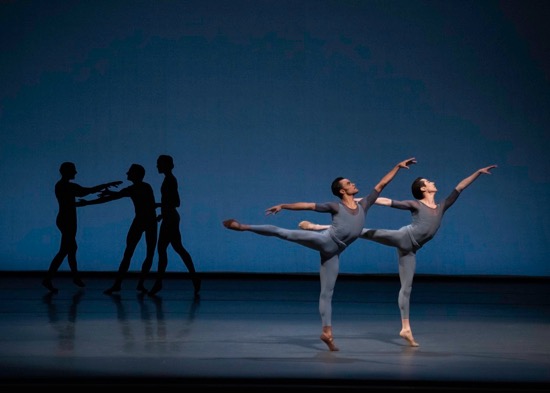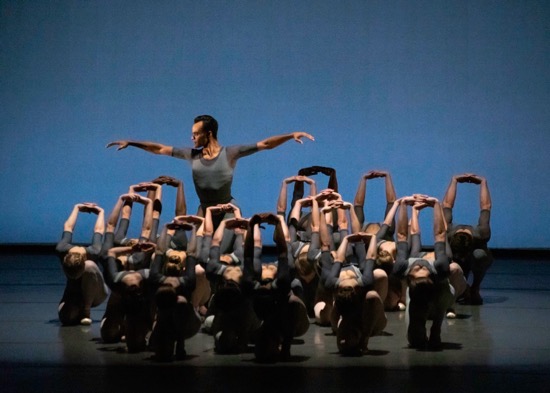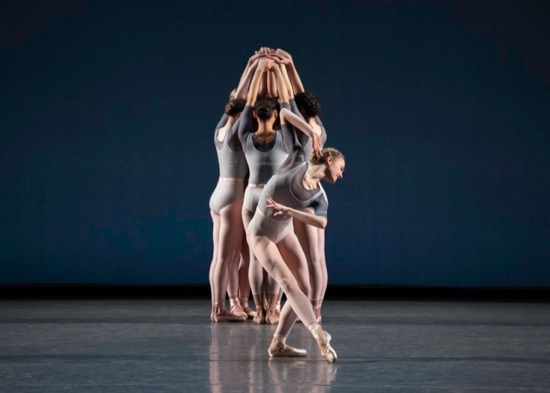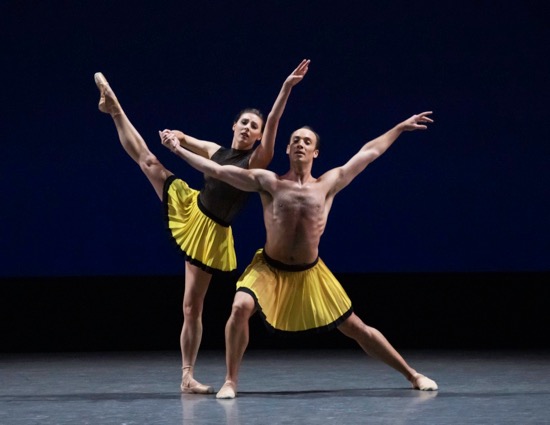
If Sir Isaac Newton had time-traveled from the late 17th–century England to 21st-century New York and found himself watching the New York City Ballet perform Justin Peck’s new Principia, would he have understood the ballet’s connection to his three-volume Philosophiæ Naturalis Principia Mathematica? You never know. But he might have understood bodies onstage being subject to gravitational pull and to attractions between them. He might have noticed that a trio, repelling one of its members, has become a duet. Do dancers, when focusing on their own paths and the natural attractions between them, not suggest that they’re participating in a somewhat askew exercise class for planets?
On the other hand, he would surely have been shocked by what would have seemed the unearthly power of Peck’s dancers. In the 17th century, ones such as Claire Kretzschmar, Tiler Peck, Brittany Pollack, Daniel Applebaum, Taylor Stanley, and Harrison Coll, would have been considered an anomaly. No one would have shown an audience the shape of a body so unashamedly and stretched it to its limits or a person who leapt so high and tangled his/her limbs with those of another.Forgive me for scrutinizing the title of what is a very heavily populated ballet: the six performers mentioned, plus Emily Kikta, Miriam Miller, Mira Nadon, a corps of nine women and six men. I of course, don’t know what strategies Peck employed in choreographing Principia; and, in the end, they don’t matter in terms of the audience’s perception. However, I do find unexpected relationships and structures not often seen on a ballet stage.
The dancers’ tights over leotards over longer-sleeved garments (by Reid Barthelme and Harriet Jung), Jennifer Tipton’s severe and sensitive lighting, and music by Sofjan Stevens (with whom Peck has collaborated four times before) conspire to create a terrain of civil, like-minded individuals going about mysterious businesses. Stevens has spoken of the influence of Etienne-Louis Boullée’s rendering for a cenotaph honoring Newton that was never built; that drawing, like Tipton’s lighting, sharply contrasts a shadowed area with a bright one. If the dancers move far upstage, they become silhouettes going about their enigmatic business.

Some of the most memorable of images in Principia involve structures made of dancers. Stanley stands at the center of a doughnut of kneeling women, their clasped hands raised behind them. Several women cluster around another one and put their hands together in a way that suggests the petals of a flower. Three inward-facing quartets of women press together, each with arms held high. You can imagine them as calyxes, since when another woman rushes around, lightly touching each group, they burst open to reveal a hidden dancer at the center (here I think more of flowers and bees than of stellar shenanigans).

I don’t fathom some of the actions I’m watching, even though I see that they have a logic. Why do people congregate to lift Stanley high and upright? What kind of relationship are Coll and Applebaum arguing over? What sets a few dancers popping up and down from a low cluster of their peers? What cosmic currents roil them into dancing, or make them curl in protectively? What makes anyone break into a solo? When they rush about in trios, it’s as if they’ve been somehow pulled into that association, rather than deciding to join up. You’re surprised to see them end the dance by coming forward in a line and holding hands.
I regret not having attended the opening programs of the NYCB’s winter season: Balanchine and Tchaikovsky, Balanchine and Stravinsky. Just watching Apollo, Orpheus, and Agon at a single performance could jolt your mind and heart into a heightened awareness of what movement can express. But it’s always interesting to see the NYCB dancers the way a younger generation of choreographers sees them, and the company members in turn appear excited by the new demands.
Forsythe likes messing with our heads; maybe he wanted to accustom us to late 20th century turmoil and disconnections. The first half of Herman Schmerman ends with the five dancers disappearing into a pit at the back of the stage that we never suspected was there.

The music by Thom Willems—abrasive and jangling—suits the snafus that shape the pas de deux. Occasionally, Tyler Angle will support Tiler Peck in an echt-classical pose on one toe, but more often the two of them are matching their rapid footwork with motions such as sliding their hips out, tilting their heads, and showing themselves to the audience butts out—all in a seamless, unstopping flow. When Angle isn’t grasping Peck’s hands to twist and untwist her in a complicated dialogue, their hands are often loose at the wrist. Their duet is a tour de force of oddities, yet it ends with him slowly revolving her as she stands on one leg, simple and erect. This is after, having finished their solos, they’ve reappeared for their coda wearing little yellow skirts. Has the sun come out in their world? Have daffodils blossomed? Don’t ask me.
To read my original response to Kyle Abraham’s engrossing The Runaway last October, please click on this link: https://www.artsjournal.com/dancebeat/2018/10/the-new-york-city-ballet-enters-a-new-era/. My view of Abraham’s work comes toward the end of a review of the Fall Gala. It was a pleasure to see the piece again and find new intrigues in it, this time with a slightly altered cast (Ashley Bouder, Georgina Pazcoguin, Roman Mejia, Peter Walker, Mearns, and Stanley were dancing their original roles, with Christopher Grant and Spartak Hoxha replacing Sebastian Villarini-Velez and Jonathan Fahoury). I was impressed all over again by the complex and fascinating solo that Abraham made for Stanley, as well as by Stanley himself, one intermission after his fine performing in Principia,and during a season in which he made his debut in Balanchine’s Apollo. Were you watching from up there, Mr. B.?

This Sufjan Stevens’ collaboration with NYCB of Principia is phenomenal. The costumes, the choreography, the simplicity of the set, and the music presented an unforgetable show. Absolutely worth the expense.